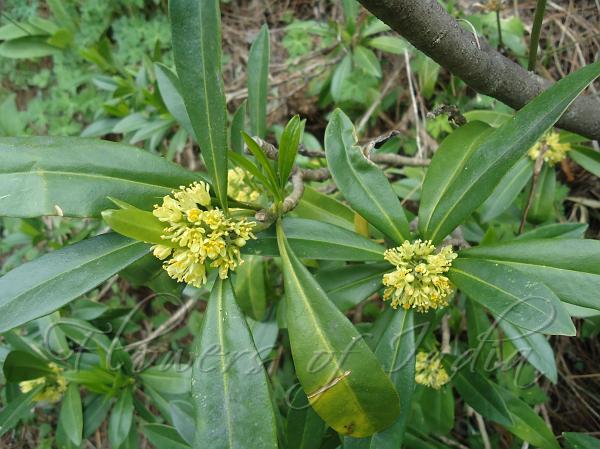|
| West-Himalayan Skimmia |
|

|

| File size | 665941 |
| Original date | 6/10/14 4:53 AM |
| Resolution | 2048 x 1536 |
| Flash | Flash did not fire, auto |
| Focal length | 4.7mm |
| Exposure time | 1/160s |
| Aperture | 2.7 |
| Focus Distance | |
| Metering Mode | Multi-segment |
| Camera make | SONY |
| Camera model | DSC-W320 |
| Sensor type |
|
|
|
|
Photo: |
Botanical name: Skimmia anquetilia Family: Rutaceae (Lemon family)
West-Himalayan Skimmia is a dioecious shrub usually
under 4 ft high, sometimes prostrate. Leaves are light green, up to
almost 7 in. long, inverted-lanceshaped or oblong-elliptic, mostly
tapering to the base for about two-thirds of their length, emitting
when crushed a very heavy and, to some people, disagreable odour;
leaf-stalk stout, up to 1.2 cm long. Inflorescence short and
very compact. Sepals are five, ovate, pointed, or blunt. Petals are
five, yellow, erect, with strongly incurved margins. Stamens about
equalling the flower, with orange anthers. Fruits dull red, up to
almost 1.2 cm long, with two or three stones. Native of the
western Himalaya as far east as W. Nepal, extending into eastern
Afghanistan; it appears to be common in the undergrowth of coniferous
forest, up to 4000 m.
Medicinal uses: Traditionally, the leaf
infusion of S. anquetilia is taken for treatment of headache, freshness
and general fever.The leaves of S. anquetilia are aromatic and known to
contain linalool, geraniol, pinene, scopoletin, skimmianine,
umbelliferone. They are used for treatment of swellings, rheumatism and
therapy. Powder of its bark is used for the healing of burns and
wounds.Its leaves is also are used for the treatment of headache and
smallpox as well as for freshness.
Traditionally, the leaf
infusion of S. anquetilia is taken for treatment of headache, freshness
and general fever.The leaves of S. anquetilia are aromatic and known to
contain linalool, geraniol, pinene, scopoletin, skimmianine,
umbelliferone. They are used for treatment of swellings, rheumatism and
therapy. Powder of its bark is used for the healing of burns and
wounds.Its leaves is also are used for the treatment of headache and
smallpox as well as for freshness.
Medicinal uses:
 Traditionally, the leaf
infusion of S. anquetilia is taken for treatment of headache, freshness
and general fever.The leaves of S. anquetilia are aromatic and known to
contain linalool, geraniol, pinene, scopoletin, skimmianine,
umbelliferone. They are used for treatment of swellings, rheumatism and
therapy. Powder of its bark is used for the healing of burns and
wounds.Its leaves is also are used for the treatment of headache and
smallpox as well as for freshness.
Traditionally, the leaf
infusion of S. anquetilia is taken for treatment of headache, freshness
and general fever.The leaves of S. anquetilia are aromatic and known to
contain linalool, geraniol, pinene, scopoletin, skimmianine,
umbelliferone. They are used for treatment of swellings, rheumatism and
therapy. Powder of its bark is used for the healing of burns and
wounds.Its leaves is also are used for the treatment of headache and
smallpox as well as for freshness. | Identification credit: Amber Srivastava | Photographed in Dhanaulti, Uttarakhand. |
• Is this flower misidentified? If yes,